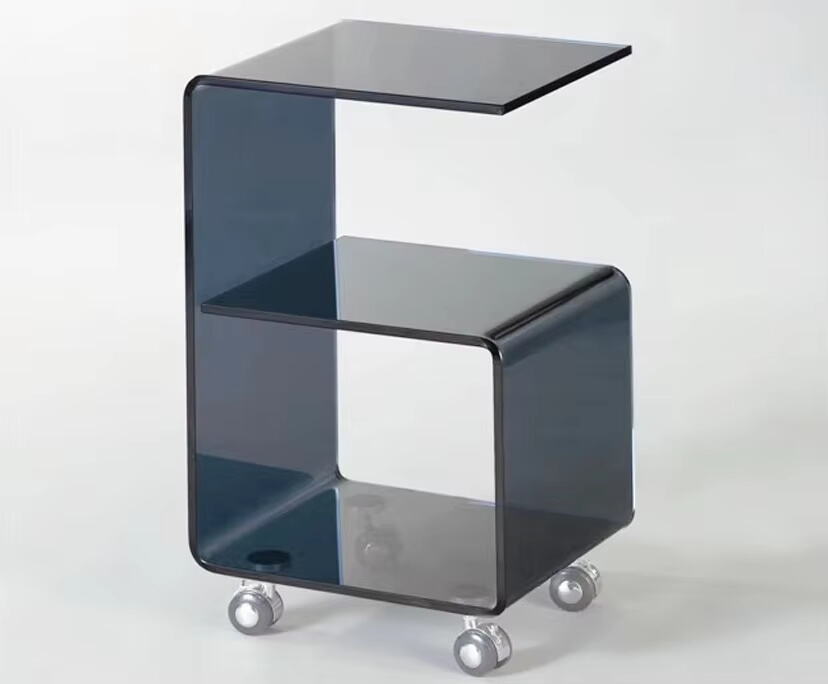นิยามกระจกโค้งและแนวปฏิวัติทางการออกแบบ
กระบวนการทำให้กระจกโค้งเกิดขึ้นได้จากเทคโนโลยีใด
การทำ กระจกโค้ง เริ่มต้นด้วยการเลือกวัสดุที่เหมาะสม โดยทั่วไปจะใช้กระจกโฟลต (float glass) เพราะให้ความใสเหมือนผลึก ซึ่งเป็นสิ่งที่ทุกคนต้องการ ในการผลิตกระจกโค้งนั้น ขั้นตอนแรกคือการให้ความร้อนกับวัสดุจนกระทั่งอ่อนตัวพอที่จะขึ้นรูป จากนั้นจึงดัดโค้งให้ได้รูปทรงตามที่ต้องการ โรงงานในปัจจุบันพึ่งพาเทคโนโลยีขั้นสูง เช่น เตาอบที่ควบคุมด้วยคอมพิวเตอร์ เพื่อให้ได้รูปทรงโค้งที่แม่นยำทุกครั้ง ความร้อนมีบทบาทสำคัญมากในกระบวนการนี้ ช่างเทคนิคจะใช้แม่พิมพ์พิเศษและเครื่องมือต่าง ๆ ในการขึ้นรูปเพื่อให้กระจกยังคงความแข็งแรงไว้ได้แม้จะถูกขึ้นรูปแล้ว หลังจากขึ้นรูปเสร็จ ก็ถึงขั้นตอนการตรวจสอบคุณภาพ พวกเขาจะทำการทดสอบเพื่อดูความหนาของกระจกในแต่ละจุด ทดสอบความทนทานเมื่อแรงดันถูกใช้ และตรวจสอบว่ากระจกสามารถทนต่อการเปลี่ยนแปลงอุณหภูมิโดยไม่แตกหักหรือไม่ ขั้นตอนทั้งหมดเหล่านี้ช่วยให้มั่นใจได้ว่าผลิตภัณฑ์สำเร็จรูปตรงตามมาตรฐานที่อุตสาหกรรมกำหนด กระบวนการทั้งหมดนี้จึงแสดงให้เห็นว่าทำไมกระจกฉนวนโค้งจึงยังคงเป็นผลิตภัณฑ์ระดับพรีเมียมในตลาดปัจจุบัน
วิวัฒนาการทางประวัติศาสตร์ในด้านการออกแบบสถาปัตยกรรม
กระจกโค้งในสถาปัตยกรรมมีการพัฒนามาอย่างยาวนาน นับตั้งแต่ครั้งแรกที่ดึงดูดความสนใจของผู้คนในช่วงต้นศตวรรษที่ 19 ด้วยรูปลักษณ์ที่ผิดแปลก ลองนึกถึงแลนด์มาร์กอย่างอาคารไทม์วอร์เนอร์เซ็นเตอร์ที่ตั้งตระหง่านอยู่ในนครนิวยอร์ก หรือแม้แต่ปิรามิดลูฟร์อันงดงามในกรุงปารีส อาคารเหล่านี้แสดงให้เห็นถึงศักยภาพของกระจกโค้งได้อย่างชัดเจนทั้งในด้านความสวยงามและความเป็นไปได้ในการใช้งาน เมื่อเทคโนโลยีก้าวหน้าไปในแต่ละยุคสมัย สถาปนิกเริ่มทดลองใช้วัสดุชนิดนี้อย่างสร้างสรรค์มากขึ้น ในปัจจุบันเครื่องมือออกแบบด้วยคอมพิวเตอร์ช่วยให้นักออกแบบสามารถคำนวณทุกสิ่งได้ละเอียด down to the last detail และยังทำให้ทางเลือกของกระจกอัจฉริยะมีราคาที่จับต้องได้มากกว่าที่เคย เราสามารถเห็นการใช้งานกระจกโค้งได้ทั่วไปในปัจจุบัน ไม่ว่าจะเป็นตึกสำนักงานหรือพิพิธภัณฑ์ ซึ่งกระจกโค้งไม่ได้เป็นเพียงแค่ส่วนตกแต่งอีกต่อไป แต่เปลี่ยนแปลงหน้าที่การใช้งานของพื้นที่จริงๆ การเปลี่ยนแปลงที่เราเห็นในแบบอาคารตลอดหลายทศวรรษที่ผ่านมานั้น แสดงให้เห็นอย่างชัดเจนว่าเทคโนโลยียังคงมีบทบาทในการเปลี่ยนแปลงเมืองของเราทั่วทั้งโลก
ข้อได้เปรียบเชิงทัศนศิลป์ของการใช้งานกระจกรูปโค้ง
การสร้างรูปแบบสถาปัตยกรรมที่ไหลลื่น
เมื่อสถาปนิกใช้กระจกโค้ง ตัวอาคารจะเริ่มดูไม่เหมือนกล่องสี่เหลี่ยมมากเท่าก่อน และดูคล้ายน้ำที่ไหลลื่นหรือทัศนียภาพทางธรรมชาติ แทนที่จะเป็นกล่องที่มีขอบตรงแบบที่เราเห็นอยู่ทั่วไป วัสดุชนิดนี้ช่วยให้นักออกแบบสามารถทดลองสร้างรูปทรงและเส้นโค้งที่น่าสนใจได้หลากหลาย ซึ่งเข้ากับสภาพแวดล้อมภายนอกได้ค่อนข้างดี ยกตัวอย่างเช่น สถาบันศิลปะลูฟร์ในอาบูดาบี โดมที่สวยงามเหล่านี้สามารถสร้างขึ้นได้ด้วยกระจกโค้ง ทำให้เกิดภาพลักษณ์ที่พิเศษและน่าประทับใจมาก คนที่เดินผ่านไปมาในอาคารลักษณะนี้น่าจะรู้สึกแตกต่างจากเวลาที่อยู่ในอาคารทั่วๆ ไป มีบางสิ่งบางอย่างเกี่ยวกับพื้นที่ที่ถูกจัดรูปแบบในลักษณะนี้ที่ทำให้ผู้คนรู้สึกผ่อนคลายและเชื่อมโยงกับสภาพแวดล้อมรอบข้างมากกว่าจะรู้สึกเหมือนติดอยู่ในพื้นที่เย็นชาและปราศจากความรู้สึก
การเสริมสร้างความต่อเนื่องทางทัศน์ภายในอาคาร
เมื่อพูดถึงการออกแบบภายใน กระจกโค้งนั้นจริงๆ แล้วสามารถทำให้พื้นที่ต่างๆ รู้สึกเชื่อมโยงกันมากกว่าแยกขาดออกจากกันอย่างน่าทึ่งเลยทีเดียว นักออกแบบมักนิยมใช้ผนังและฉากกั้นแบบโค้งเหล่านี้ เนื่องจากสามารถกำจัดมุมที่ดูแข็งกระด้างออกไป ทำให้ห้องต่างๆ รู้สึกเชื่อมโยงกันมากขึ้น ผลลัพธ์ที่ได้คือพื้นที่ต่างๆ จะไหลลื่นเชื่อมต่อกันได้อย่างลงตัว นอกจากนี้ กระจกโค้งยังช่วยให้แสงธรรมชาติเข้ามาได้มากขึ้น ทำให้ห้องดูกว้างขึ้นกว่าความเป็นจริง มีงานวิจัยบางส่วนยืนยันเรื่องนี้ด้วย โดยทั่วไปแล้วผู้คนมักจะรู้สึกมีความสุขและสบายใจมากขึ้นเมื่อมีแสงแดดธรรมชาติสาดส่องเข้ามาอย่างเพียงพอ และยังมีเรื่องของโอกาสในการตกแต่งอีกมากมาย กระจกโค้งเปิดโอกาสให้สร้างสรรค์ได้อย่างหลากหลาย เพื่อเพิ่มสไตล์โดยยังคงความเป็นประโยชน์ใช้สอยไว้ ไม่ว่าจะเป็นการติดตั้งเชิงศิลปะหรือรายละเอียดตกแต่งเล็กๆ น้อยๆ พื้นผิวเหล่านี้สามารถเปลี่ยนพื้นที่ภายในธรรมดาๆ ให้กลายเป็นสิ่งที่พิเศษ โดยไม่ต้องแลกมาด้วยความสะดวกในการใช้งาน
การออกแบบราวบันไดกระจกภายในที่เปลี่ยนโฉมใหม่
ราวจับกระจกโค้งกำลังเปลี่ยนเกมการออกแบบพื้นที่ภายในอาคาร มันให้ความปลอดภัยโดยไม่บดบังทัศนียภาพที่คนต้องการมองเห็นด้านนอก จุดประสงค์หลักคือการสร้างสรรค์การออกแบบที่ใช้วัสดุโปร่งใสเป็นหลักแทนกำแพงหรือรั้วแบบดั้งเดิม แสงสว่างธรรมชาติสามารถส่องผ่านการติดตั้งเช่นนี้ได้อย่างเต็มที่ แต่ยังคงช่วยปกป้องผู้คนจากการพลัดตก ลองดูโครงการก่อสร้างล่าสุดในพื้นที่รอบเมือง - หลายแห่งเริ่มใช้ราวจับกระจกโค้งในล็อบบี้และทางเดินของพวกเขา เพราะมันเปลี่ยนจริงๆ ว่าผู้คนจะรับรู้ถึงพื้นที่อย่างไร แน่นอนว่ากระจกจำเป็นต้องได้รับการดูแลเป็นพิเศษในพื้นที่ที่มีผู้คนสัญจรไปมาตลอดทั้งวัน แต่ปัจจุบันมีการพัฒนากระบวนการพิเศษที่ช่วยปกป้องพื้นผิวกระจกจากรอยขีดข่วนและการกระแทก นอกจากนี้ ผู้ผลิตยังคิดค้นวิธีการเสริมความแข็งแรงให้กับกระจกเพื่อให้มีอายุการใช้งานยาวนานขึ้น ทั้งหมดนี้ทำให้ตัวเลือกกระจกโค้งใช้งานได้ดีไม่เพียงแค่เรื่องความสวยงาม แต่ยังทนทานต่อการใช้งานประจำวันอีกด้วย
ประโยชน์ในการออกแบบเชิงหน้าที่สำหรับพื้นที่สมัยใหม่
การกระจายแสงธรรมชาติอย่างมีประสิทธิภาพ
กระจกโค้งมีบทบาทสำคัญในการนำแสงแดดเข้าสู่อาคารสมัยใหม่มากยิ่งขึ้น ซึ่งหมายความว่าเราไม่จำเป็นต้องพึ่งพาแสงสว่างเทียมมากเหมือนเดิม อีกทั้งเมื่อติดตั้งอย่างเหมาะสม พื้นผิวโค้งเรียบเหล่านี้จะช่วยให้แสงธรรมชาติส่องเข้าไปในพื้นที่ห้องต่างๆ และบริเวณทำงานได้ลึกยิ่งขึ้น ทำให้ทุกสิ่งดูสว่างไสวและน่าอยู่มากขึ้น งานวิจัยชี้ให้เห็นว่าผู้คนมักมีประสิทธิภาพในการทำงานมากขึ้นเมื่อได้รับแสงธรรมชาติเพียงพอ นอกจากนี้ อารมณ์โดยรวมของพวกเขาก็มักดีขึ้นอีกด้วย ในระยะยาว อาคารที่ใช้กระจกโค้งอย่างมีประสิทธิภาพจะช่วยประหยัดค่าไฟฟ้า เพราะลดการพึ่งพาแสงไฟฟ้าในเวลากลางวัน สถาปนิกจึงเริ่มมองว่าการใช้กระจกโค้งเป็นทางเลือกที่ให้ประโยชน์ทั้งบ้านพักอาศัยและอาคารสำนักงานอย่างเท่าเทียมกัน
การเปลี่ยนผ่านระหว่างพื้นที่ภายในและภายนอกอย่างไร้รอยต่อ
กระจกโค้งช่วยให้การเปลี่ยนผ่านระหว่างพื้นที่ภายในและภายนอกมีความราบรื่นทั้งในด้านทัศน์และการรับรู้ทางกายภาพ ซึ่งช่วยเพิ่มคุณภาพในการสัมผัสประสบการณ์ของผู้คนต่อสภาพแวดล้อมที่อยู่อาศัยได้อย่างแท้จริง ปัจจุบันหลาย ๆ แนวโน้มการออกแบบมุ่งเน้นการผสมผสานทัศนียภาพภายนอกเข้ากับพื้นที่ภายในอาคาร และกระจกโค้งนี้เองก็สามารถตอบโจทย์ด้านความสมดุลในลักษณะเช่นนี้ได้อย่างยอดเยี่ยม เมื่อพูดถึงสถาปัตยกรรมและการออกแบบตกแต่งภายใน มืออาชีพมักกล่าวถึงความสำคัญของพื้นที่เปลี่ยนผ่านเหล่านี้อย่างต่อเนื่อง โดยเน้นว่ามันช่วยสร้างสภาพแวดล้อมที่ทำให้ผู้คนรู้สึกเชื่อมโยงกับธรรมชาติ แทนที่จะถูกตัดขาดจากธรรมชาติ หากพิจารณาโครงการก่อสร้างล่าสุด คุณจะเห็นได้ว่ากระจกโค้งกำลังทำหน้าที่นี้อย่างแม่นยำ นั่นคือการเปิดทัศนียภาพแบบต่อเนื่องไร้รอยต่อที่สร้างความแตกต่างให้กับสถาปัตยกรรมสมัยใหม่ในปัจจุบัน
ประสิทธิภาพด้านเสียงในงานออกแบบที่อยู่อาศัย
กระจกโค้งมีความสามารถพิเศษที่น่าสนใจเมื่อพูดถึงการควบคุมเสียง ซึ่งเป็นเหตุผลว่าทำไมบ้านสมัยใหม่จำนวนมากจึงนิยมใช้มันในปัจจุบัน รูปทรงของกระจกที่โค้งงอนั้นช่วยป้องกันเสียงรบกวนจากภายนอกได้จริง ๆ ทำให้เสียงถนนและเสียงการจราจรลดลง โดยยังคงความสวยงามของหน้าต่างขนาดใหญ่ไว้ได้ สถาปนิกหลายรายได้สังเกตพบถึงคุณสมบัตินี้ด้วยตนเอง จากโครงการระดับพรีเมียมที่ผู้อยู่อาศัยร้องขอให้เพิ่มประสิทธิภาพในการควบคุมเสียงโดยเฉพาะ ผู้เป็นเจ้าของบ้านที่ติดตั้งกระจกโค้งต่างรายงานว่าภายในบ้านเงียบสงบมากขึ้นอย่างชัดเจน เมื่อเทียบกับการใช้กระจกเรียบแบบดั้งเดิม แม้ว่ากระจกโค้งจะไม่ใช่คำตอบวิเศษสำหรับปัญหาเสียงทุกประเภท แต่มันก็ช่วยสร้างบรรยากาศภายในบ้านให้เงียบสงบตามที่ผู้คนต้องการในปัจจุบันได้อย่างเห็นได้ชัด
การนำกระจกโค้งมาใช้ในหลากหลายแง่มุมของการออกแบบ นอกจากจะเสริมสร้างความสวยงามแล้ว ยังมีประโยชน์ในเชิงการใช้งานจริง ที่มีบทบาทสำคัญต่อสถาปัตยกรรมสมัยใหม่และการใช้ชีวิตในที่อยู่อาศัย เป็นวัสดุที่สร้างสรรค์และทันสมัย ซึ่งยังคงมีการพัฒนาเปลี่ยนแปลงพื้นที่ต่าง ๆ ด้วยการเพิ่มประสิทธิภาพในการกระจายแสง ทำให้การเปลี่ยนผ่านระหว่างพื้นที่ต่าง ๆ เป็นไปอย่างราบรื่น และยกระดับประสิทธิภาพทางด้านเสียง
คุณลักษณะด้านประสิทธิภาพพลังงานและความยั่งยืน
กระจกฉนวนแบบโค้งสำหรับควบคุมอุณหภูมิ
เมื่อพูดถึงการรักษาอุณหภูมิให้ตึกอาคารให้ร้อนในฤดูหนาวและเย็นในฤดูร้อน กระจกโค้งที่มีฉนวนกันความร้อนนั้นทำงานได้ดีกว่าแผ่นกระจกแบนมาตรฐาน เนื่องจากรูปทรงของมัน กระจกประเภทนี้สามารถติดตั้งได้แนบสนิทกับโครงสร้างอาคารมากขึ้น ซึ่งหมายความว่ามีช่องว่างน้อยลงสำหรับให้อากาศอุ่นรั่วไหลในช่วงอากาศเย็น หรือให้ความร้อนภายนอกเข้ามาเมื่ออุณหภูมิเพิ่มขึ้น อาคารที่ติดตั้งกระจกประเภทนี้โดยทั่วไปจะเห็นค่าใช้จ่ายด้านพลังงานลดลงอย่างเห็นได้ชัด การวิจัยจากหลายแหล่งข้อมูลชี้ให้เห็นว่าอาคารที่ใช้กระจกโค้งที่มีฉนวนกันความร้อนตลอดการออกแบบสามารถลดค่าใช้จ่ายในการทำความร้อนและทำให้เย็นได้ประมาณ 20% สถาปนิกชื่นชอบวัสดุชนิดนี้เพราะมีลักษณะสวยงามขณะเดียวกันก็ทำหน้าที่เป็นฉนวนกันความร้อน ช่วยให้สามารถสร้างอาคารที่โดดเด่นด้านทัศน์ได้ โดยไม่ต้องแลกมาด้วยความไม่สะดวกสบายหรือค่าใช้จ่ายในการดำเนินงานที่เพิ่มขึ้น
การวิเคราะห์ต้นทุน-ผลตอบแทนของกระจกอัจฉริยะ
เมื่อพิจารณาค่าใช้จ่ายของเทคโนโลยีกระจกอัจฉริยะเทียบกับสิ่งที่มันช่วยประหยัดได้ ชัดเจนว่าการเปลี่ยนมาใช้มีมูลค่าในตัวเอง แม้ว่าราคาเริ่มต้นจะสูงกว่ากระจกทั่วไป แต่ก็คุ้มค่าในระยะยาว เนื่องจากช่วยควบคุมอุณหภูมิภายในอาคารได้ดีขึ้น ทำให้ค่าพลังงานลดลงเรื่อยๆ ตามระยะเวลาที่ใช้งาน มีการศึกษาหลายชิ้นแสดงว่า อาคารที่ติดตั้งกระจกอัจฉริยะสามารถลดค่าใช้จ่ายด้านพลังงานประจำปีได้ประมาณ 30 เปอร์เซ็นต์ เพียงแค่ควบคุมปริมาณความร้อนที่เข้าออกอาคารได้อย่างมีประสิทธิภาพ ในปัจจุบันเรามักเห็นสถาปนิกเลือกใช้กระจกอัจฉริยะมากขึ้นในการออกแบบอาคารที่เป็นมิตรต่อสิ่งแวดล้อม เพราะลูกค้าต้องการอาคารที่ทำงานได้อย่างมีประสิทธิภาพและยังรักษาสิ่งแวดล้อมไปพร้อมกันด้วย การผสมผสานระหว่างฟังก์ชันเทคโนโลยีกับประโยชน์ใช้สอยที่ได้รับ ทำให้เรากำลังก้าวเข้าสู่ยุคที่อาคารไม่เพียงแค่มองดูดีในเอกสารเท่านั้น แต่ยังทำงานได้อย่างยั่งยืนในทุกๆ วัน
กลยุทธ์การจัดการพลังงานแสงอาทิตย์
การควบคุมการรับความร้อนจากแสงอาทิตย์ยังคงมีความสำคัญอย่างมากในการทำให้อาคารที่มีผนังกระจกโค้งมีประสิทธิภาพพลังงานที่ดี ช่วยได้โดยการใช้สารเคลือบพิเศษบนพื้นผิวกระจกร่วมกับระบบบังแดดด้านนอก ซึ่งช่วยจัดการปริมาณแสงอาทิตย์ที่จะเข้าสู่ภายในอาคารได้จริง เรามีโอกาสเห็นแนวทางนี้ให้ผลลัพธ์ที่ดีในทางปฏิบัติผ่านโครงการเชิงพาณิชย์หลายแห่ง โดยบางโครงการรายงานว่าประสิทธิภาพพลังงานดีขึ้นราว 25 เปอร์เซ็นต์ หลังจากนำวิธีการเหล่านี้ไปใช้ ในอนาคต สถาปนิกและวิศวกรมีการพัฒนาเทคโนโลยีใหม่ๆ โดยเฉพาะที่ออกแบบมาเพื่อใช้งานกับกระจกโค้งโดยเฉพาะ นวัตกรรมเหล่านี้คาดว่าจะช่วยควบคุมสภาพภูมิอากาศภายในอาคารได้ดีขึ้น พร้อมทั้งลดการพึ่งพาอาศัยระบบทำความร้อนและทำให้เย็นแบบกลไก เมื่อมาตรฐานอาคารสีเขียวยังคงมีการพัฒนาต่อไป การวางแผนอย่างเหมาะสมตั้งแต่เริ่มต้นจึงมีความสำคัญมากยิ่งขึ้น เพื่อให้สามารถประหยัดพลังงานได้สูงสุดในอาคารยุคใหม่ที่มีผนังกระจกโค้ง
นวัตกรรมโครงสร้างและความปลอดภัย
ความทนทานที่เพิ่มขึ้นจากการอบแข็ง
กระจกนิรภัยมีความโดดเด่นอย่างมากเมื่อพูดถึงการเพิ่มความทนทานให้กับผลิตภัณฑ์ โดยเฉพาะในดีไซน์ที่เป็นแบบโค้งซึ่งเราได้เห็นกันอยู่บ่อย ๆ ในปัจจุบัน เมื่อผู้ผลิตทำการนิรภัยกระจก พวกเขาจะให้ความร้อนกับกระจกจนถึงระดับอุณหภูมิสูงมาก จากนั้นจึงทำให้เย็นตัวลงอย่างรวดเร็ว ซึ่งกระบวนการนี้จะช่วยเพิ่มความแข็งแรงให้กับกระจกโดยรวม ผลลัพธ์ที่ได้คือ กระจกนิรภัยสามารถรับแรงกระแทกได้มากกว่ากระจกธรรมดาถึงประมาณห้าเท่า ก่อนที่จะแตก สถาปนิกนิยมใช้วัสดุนี้ในงานก่อสร้างอาคารต่าง ๆ เนื่องจากให้ความปลอดภัยที่เพิ่มขึ้น โดยเฉพาะในห้างสรรพสินค้าและอาคารสำนักงานที่ผู้คนสัญจรไปมาตลอดทั้งวัน เทคโนโลยีที่ใช้ในการทำให้กระจกนิรภัยก็พัฒนาให้ดีขึ้นเรื่อย ๆ เช่นกัน ปัจจุบันเราจึงได้เห็นผลิตภัณฑ์กระจกที่ไม่เพียงแต่มีอายุการใช้งานยาวนานขึ้น แต่ยังมีสมรรถนะที่ดีกว่าเมื่ออยู่ภายใต้สภาวะที่มีแรงกดดัน นี่จึงเป็นเหตุผลที่โครงสร้างสมัยใหม่จำนวนมากเลือกใช้กระจกนิรภัยแทนทางเลือกแบบดั้งเดิม
ความต้านทานต่อแรงกระแทกในสภาพแวดล้อมที่มีความท้าทาย
กระจกโค้งที่ถูกออกแบบมาเป็นพิเศษมีความทนทานต่อแรงกระแทกได้ค่อนข้างดี ซึ่งทำให้เป็นทางเลือกที่ชาญฉลาดสำหรับสถานที่ต่างๆ เช่น ศูนย์การค้า โรงเรียน และอาคารของรัฐบาล ที่ซึ่งความปลอดภัยของผู้คนมีความสำคัญมากที่สุด ผู้ผลิตใช้สารเคลือบพิเศษและชั้นวัสดุหลายชั้นเพื่อเพิ่มความแข็งแรงทนทานของกระจกชนิดนี้ เมื่อเกิดเหตุไม่คาดคิดในช่วงสภาพอากาศเลวร้าย หรือเมื่อมีคนพยายามบุกเข้าไปในอาคาร แผงกระจกที่เสริมความแข็งแรงเหล่านี้จะช่วยลดทั้งอาการบาดเจ็บและค่าใช้จ่ายในการซ่อมแซมที่สูงลิ่ว งานวิจัยบางชิ้นชี้ว่า การติดตั้งกระจกนิรภัยชนิดนี้อาจช่วยป้องกันการบาดเจ็บได้ประมาณครึ่งหนึ่งของจำนวนการบาดเจ็บทั้งหมดที่อาจเกิดจากกระจกแตก ในอนาคต สถาปนิกและนักวิทยาศาสตร์ด้านวัสดุกำลังพัฒนาวิธีการใหม่ๆ ที่จะทำให้อาคารมีความปลอดภัยมากยิ่งขึ้น โดยยังคงรักษาความสวยงามของดีไซน์ไว้ได้ นอกจากนี้ เรายังได้เห็นพัฒนาการที่น่าตื่นเต้นในเรื่องปฏิสัมพันธ์ระหว่างกระจกกับวัสดุอื่นๆ อีกด้วย
ความหลากหลายในการประยุกต์ใช้ทางสถาปัตยกรรม
ผนังอาคารพาณิชย์
กระจกโค้งกําลังเปลี่ยนวิธีที่เราคิดเกี่ยวกับภายนอกอาคารพาณิชย์ ช่วยให้บริษัทสร้างรุ่นเครื่องหมายที่แข็งแกร่งขึ้น และทําให้อาคารของพวกเขาดูดีขึ้นด้วย ผู้ประกอบการเพิ่มมากขึ้น กําลังหันไปใช้กระจกโค้ง สําหรับโครงการของพวกเขา เพราะมันทําให้มีหน้าต่างใหญ่ขึ้น และปล่อยให้แสงธรรมชาติเข้ามาก นั่นหมายความว่า ค่าพลังงานที่ลดลง จากความต้องการแสงที่ลดลง และสร้างภาพที่น่าทึ่ง ที่ดึงดูดความสนใจของผู้คน เมื่อสถาปนิกทํางานกับกระจกโค้ง พวกเขาต้องตรวจสอบหลายอย่างก่อน พวกเขาดูว่าโครงสร้างสามารถรับน้ําหนักได้หรือไม่ กระจกจะทนต่อสภาพอากาศที่แตกต่างกันได้หรือไม่ และมันจัดการการถ่ายส่งความร้อนได้ดีแค่ไหน ระหว่างฤดูกาล อาคารที่น่าประทับใจในโลกนี้ มีผนังแก้วโค้งนี้ แสดงถึงเทคโนโลยีนี้ได้ก้าวไกลแค่ไหน สิ่งที่น่าสนใจคือการเห็นว่า กระจกโค้งได้เปลี่ยนจากความเป็นเรื่องใหม่ เป็นการปฏิบัติตามมาตรฐานในการออกแบบทางการค้าที่ทันสมัย
ผนังประดับและฉากกั้นภายในบ้าน
กระจกโค้งกลายเป็นที่นิยมมากขึ้นเรื่อยๆ ใน หน้าแรก การออกแบบล่าสุด ทำหน้าที่ทั้งเป็นจุดเด่นทางสไตล์และองค์ประกอบที่ใช้งานได้จริง เมื่อใช้สำหรับผนังเด่นหรือฉากกั้นห้อง จะช่วยเปลี่ยนบรรยากาศภายในห้องโดยสิ้นเชิง กระจกที่โค้งรับมุมห้องสร้างการเปลี่ยนผ่านอย่างราบรื่นระหว่างพื้นที่ต่างๆ ในบ้านขณะที่ยังคงให้แสงธรรมชาติส่องผ่านได้อย่างเต็มที่ บ้านสมัยใหม่หลายหลังตอนนี้มีส่วนกระจกโค้งเหล่านี้ โดยเฉพาะในแบบบ้านที่มีพื้นที่เปิดโล่ง ซึ่งช่วยให้พื้นที่เล็กๆ ดูกว้างขึ้นกว่าที่มีจริง แนวโน้มการใช้วัสดุโปร่งใสกำลังได้รับความนิยมมากขึ้นในขณะนี้ เนื่องจากเจ้าของบ้านต้องการให้สภาพแวดล้อมในการอยู่อาศัยของพวกเขามีความโปร่งสบายและน่าอยู่ เป็นเหตุผลที่ทำให้เราเห็นสถาปนิกจำนวนมากขึ้นเรื่อยๆ นำเอาองค์ประกอบกระจกโค้งเข้ามาไว้ในโครงการล่าสุดของพวกเขา เพื่อตอบโจทย์ลูกค้าที่ต้องการสิ่งที่พิเศษและแตกต่าง
การนำกระจกโค้งไปใช้ร่วมกับยานยนต์และเฟอร์นิเจอร์
กระจกโค้งไม่ได้ถูกใช้แค่เฉพาะในอาคารอีกต่อไป ผู้ผลิตรถยนต์เริ่มนำกระจกโค้งมาใช้มากขึ้นเช่นกัน โดยส่วนใหญ่เป็นเพราะช่วยเพิ่มความปลอดภัยให้กับรถยนต์ ขณะเดียวกันก็ให้ลุคที่ดูทันสมัยและเท่ห์ขึ้น เมื่อรถยนต์มีกระจกหน้าและกระจกข้างที่เป็นแบบโค้ง จะช่วยลดแรงต้านของอากาศ เพิ่มทัศนวิสัยในการมองเห็นรอบมุมรถให้กับผู้ขับขี่ และทำให้โครงสร้างตัวรถโดยรวมมีความแข็งแรงมากยิ่งขึ้น สำหรับผู้ผลิตเฟอร์นิเจอร์ กระจกโค้งยังช่วยเพิ่มความพิเศษให้กับพื้นโต๊ะหรือชั้นวางหนังสือ ลวดลายการสะท้อนของแสงที่เกิดขึ้นบนพื้นผิวโค้งให้ความรู้สึกน่าสนใจ และขอบที่มนเวลากคนสัมผัสจะรู้สึกดีกว่าเดิ้ม นักออกแบบตกแต่งภายในนิยมใช้วัสดุนี้อย่างแพร่หลายในปัจจุบัน โดยเฉพาะอย่างยิ่งเนื่องจากผู้ซื้อบ้านต้องการพื้นที่ที่มีเอกลักษณ์ ไม่ซ้ำแบบบ้านจัดสรรทั่วไป ด้วยเทคโนโลยีและเทคนิคการผลิตใหม่ๆ ที่พัฒนาขึ้นอย่างต่อเนื่อง เราอาจได้เห็นการใช้งานกระจกโค้งในรูปแบบที่สร้างสรรค์มากยิ่งขึ้นในอนาคตอันใกล้ ไม่ว่าจะเป็นผนังกั้นสำนักงาน หรือแม้กระทั่งพื้นที่นั่งเล่นกลางแจ้ง

ส่วน FAQ
ข้อได้เปรียบหลักในการใช้กระจกโค้งในงานสถาปัตยกรรมคืออะไร?
กระจกโค้งมอบความสวยงามและการใช้งานที่ลงตัว เช่น การกระจายแสงธรรมชาติได้ดีขึ้น มีประสิทธิภาพในการประหยัดพลังงาน และเพิ่มประสิทธิภาพด้านเสียง
กระจกโค้งช่วยเสริมการออกแบบภายในอย่างไร?
กระจกโค้งช่วยเพิ่มการมองเห็นแบบต่อเนื่อง ให้การเปลี่ยนผ่านระหว่างพื้นที่เป็นไปอย่างลื่นไหล และเพิ่มการส่องผ่านของแสงธรรมชาติ ทำให้พื้นที่ภายในดูกว้างขึ้นและโล่งมากขึ้น
กระจกโค้งสามารถช่วยประหยัดพลังงานได้หรือไม่?
ได้ กระจกโค้งที่มีฉนวนสามารถลดการใช้พลังงานได้อย่างมาก ประหยัดพลังงานสำหรับการทำความร้อนและความเย็นได้ถึง 20%
กระจกโค้งมีราคาแพงกว่ากระจกธรรมดาหรือไม่?
แม้ราคาเริ่มต้นอาจสูงกว่า แต่การประหยัดในระยะยาวจากการใช้พลังงานอย่างมีประสิทธิภาพมักจะทำให้กระจกโค้งเป็นทางเลือกที่คุ้มค่า
การพิมพ์สามมิติส่งผลต่อการออกแบบกระจกโค้งอย่างไร?
การพิมพ์สามมิติช่วยให้ปรับแต่งและออกแบบได้หลากหลายมากขึ้น ขยายโอกาสในการใช้งานกระจกโค้งในภาคส่วนสถาปัตยกรรมและการออกแบบต่าง ๆ


